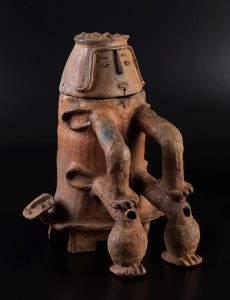
Venus of Santarem (Brazil, ca. 1400-1000 BC)
When did people get to Brazil?
The first people probably arrived on the Atlantic coast of South America about 15,000 BC. Probably a second wave of people followed them around 11,000 BC.
People reach the Americas
Brazil and colonization
All our South America articles
How did they get there?
The first people to reach Brazil were following the Atlantic coastline south from Central America. It’s also possible, though not very likely, that other people reached South America by boat from Australia or Indonesia.
The Olmec in Central America
Fishing and shellfish in Brazil
As they followed the coast south with their dogs, these people lived mostly on seaweed, shellfish, shrimp, and fish, which they preserved by fermenting them in baskets lined with clay so they would hold salty water. This is the same way people preserved fish in Japan, and possibly these people brought their baskets and their love of pickled fish with them from northern Asia.
History of fishing
Where did dogs come from?
Stone Age Japan
Early use of pottery in Brazil
By around 5500 BC, Brazilians were making pottery jars to pickle their fish in. They probably pickled their fish in seawater – which is totally a thing – in order to preserve them. Probably they boiled the seawater to evaporate some of the water, first, to make the brine a little saltier than seawater is.
History of pottery
The Stone Age around the world
The beginnings of farming in Brazil

Yuca plants after they’re pulled up
Slowly Brazilians spread out along the banks of the Amazon river, moving away from the coast further inland. Some towns along the Amazon had tens of thousands of houses. And it wasn’t all fish, all the time: these people also ate peanuts, cacao beans, and yuca roots (a starchy root like a potato) and leaves, among other things.
Where do peanuts come from?
History of chocolate
What is yuca root?
At first they were gathering these foods in the wild. But by about 2800 BC, Brazilians were probably farming along the Atlantic coast. Mmm, peanuts and chocolate: two great tastes that go great together! (It’s not an accident that we have Reeses’ Cups, in other words.)
What about the Tupi people?

Brazilian pottery (500-1200 AD)
The Tupi people, on the other hand, came south from Central America and settled in the center of South America. They may have been the ones who domesticated yuca root, about 10,000 BC.
The Tupi made most of their tools out of wood or bone, because flint and obsidian were rare in central South America.
The Tupi expand south and east
About 900 BC, the Tupi began to conquer south and east towards the coast. Starting around 500 BC, some of them went further south into Paraguay, conquered the people there, and became the Guarani.
More about the Guarani
Other Tupi people conquered the big towns along the coast of Brazil and settled there. Many of the conquered people, who we call the Tapuias, had to move further inland, away from the coast, though some stayed along the coast too.
Life in Brazil in the Middle Ages

A funerary urn (for someone’s ashes) from northern Brazil, about 1000 AD – one of the objects that was in the museum that burned.
These big Tupi and Tapuia towns, and their rulers, sometimes got into wars. They may have been fighting over who got to live on the coast where the fish were, and who had to live further inland.
More about farming
History of corn
What is irrigation?
Around this same time, farming became more important and more commercially organized. In the south (modern Argentina), they farmed corn that they may have gotten from the Guarani to their east.
Further north (in modern Brazil), they farmed yuca root, and in the mountains along the Argentinian coast people used irrigation to farm peanuts.
More about the history of corn
All these people also farmed beans, sweet potatoes, chili peppers, and yams.
History of beans
Where do chili peppers come from?
What about sweet potatoes?
But people in Brazil also kept on eating a lot of seafood and seaweed, making huge piles of seashells along the coast. That’s where things stood when the first European explorers arrived from Portugal in April of the year 1500 AD.